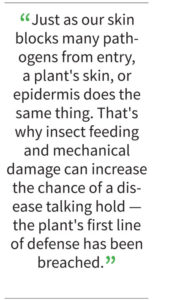Be sure to sanitize tools regularly to halt the spread of disease from one plant to another
By Kate Russell
Plants may not have an active immune system, but that doesn’t mean they just roll over and take whatever hits them. When pathogens strike, plants can respond in two different ways: they use structures and chemicals already in place, and they can make changes when a pathogen is sensed.
Just as our skin blocks many pathogens from entry, a plant’s skin, or epidermis, does the same thing. That’s why insect feeding and mechanical damage can increase the chance of a disease taking hold — the plant’s first line of defense has been breached.
Plant cell walls also block viruses, bacteria, and fungi. Unlike our human immune system, which uses white blood cells to actively hunt down and destroy invaders, plant cells have antimicrobial defenses built right in.
 These defenses take the form of saponins, glucosides, and antimicrobial proteins. Enzyme inhibitors can also stop some pathogens from feeding on the plant. Plants also have chemicals that can neutralize toxins created by a pathogen. Finally, receptors can recognize a pathogen and alert the plant to take further action.
These defenses take the form of saponins, glucosides, and antimicrobial proteins. Enzyme inhibitors can also stop some pathogens from feeding on the plant. Plants also have chemicals that can neutralize toxins created by a pathogen. Finally, receptors can recognize a pathogen and alert the plant to take further action.
Once a pathogen is recognized, cell walls are reinforced and defensive chemicals, such as hydrogen peroxide, as well as those enzymes and proteins, are manufactured.
In some cases, plants have evolved a behavior called a ‘hypersensitive response’ in which the tissue surrounding an infection is killed off, to block further infection to neighboring cells.
Rather than treating a disease after it occurs, it is far easier to grow plants that have built-in defenses. This reduces the need for pesticides and fungicides.
When shopping for plants, look at the plant label to see if that particular variety is resistant to diseases that tend to appear in your garden. Plant labels use the following codes to designate specific disease resistances:
A – Alternaria stem canker
F – Fusarium wilt
N – Nematodes
T – Tobacco mosaic virus (TMV)
S – Stemphylium gray leaf spot
V – Verticillium wilt
So, if you see a plant label with the letters, V, F, and N on it, that particular plant is resistant against verticillium wilt, fusarium wilt, and nematodes. This does not mean the plant is guaranteed to not get these diseases, but it does mean the chances are significantly lower.
You can help your plants fight disease by selecting resistant varieties, spacing your plants properly, employing crop rotation, and providing an adequate amount of water and nutrients.
Also, be sure to sanitize your tools regularly, to halt the spread of disease from one plant to another.
Kate Russell is a UCCE Master Gardener in Santa Clara County. For more information, visit mgsantaclara.ucanr.edu or call (408) 282-3105 between 9:30 a.m. and 12:30 p.m. Monday through Friday.







